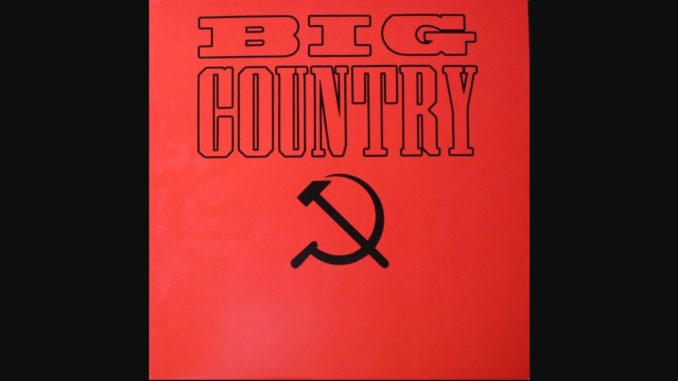
On 9 September 1988, Big Country released their fourth album Peace In Our Time on an unsuspecting world.
The album is still debated amongst fans. Several people quite like it, others think less of it, but it undeniably saw the band moving further away from the sound they had initially become known for. The album was crafted to be more in tune with what was happening on the American charts in an attempt to ‘make it’ over there.
Universal’s A&R man Dave Bates was the one orchestrating this move. He commented: “The hope was that by recording the album in America and being in America, it would have a certain ambiance, a certain atmosphere that the band could work within, and a certain influence. You know, the guys being out there, living out there. I thought by bringing Peter Wolf in, we would end up with something more American-friendly. That was the plan, anyway.”
In addition to the musical style, the album is at least equally remembered for the PR activities surrounding its launch. These activities were inspired by the album title, which also shaped the cover art (which depicted a cityscape with buildings from both the east and the west). It reflected the political winds of change that saw a thawing of relations between the east and west. Perestroika. Politicians from different sides of the iron curtain were talking. Relationships were growing.
Big Country tapped into this, but if their unified utopian cityscape on the album cover wasn’t a clear enough message, it was even stronger on the Peace In Our Time single. That cover displayed a huge “stars and stripes”-flag with a hammer and sickle in place of the stars.
The album launch and immediate PR activities would all play into this, and manager Ian Grant had huge plans. It was to start with an album launch, including a performance and a press conference on 21 September 1988.
Where? At the Soviet Embassy in London.
Even today this choice of location would have been noteworthy. Back then it was almost inconceivable. A Western rock band playing and staging a press conference with the help of the Soviet Union? It was simply unheard of, but it did position the band very uniquely. It was almost as if the band had a part to play in opening things up a little more; that they assisted the building of bridges. It was impossible to separate their choice of location from what was happening politically in the world at large at the time. This also placed the band in that context.
The band was not just content to launch an album on Soviet soil though. At the press conference, they announced to the world that just a week later, they would play the first of a string of festival shows in the Soviet Union.
In the Storm Thorgerson-directed documentary about the Moscow adventures, called River of Hope – Big Country in Moscow, we get to follow the band and entourage on the trials and tribulations of their trip. In it, Big Country co-manager Alan Edwards gives credit for the idea to his partner and fellow Big Country co-manager Ian Grant: “Around that time the Reagan/Gorbachev summit was happening in Iceland. There was a lot of meetings and discussions on it. And the sort of idea entered people’s head, but particularly Ian Grant’s head, ‘What a great idea, we could do something to bring together different nationalities and bring together the east and the west.’”
It fit the pattern of so many things suddenly seeming possible for the first time. After years of looking at each other from afar, the Soviet Union was connecting with the rest of the world. Why should not the rest of the world try to connect back? And if a music act should have a part to play in that, who better than Big Country?
Several western artists had performed individual shows in the Soviet Union. Big Country planned to be the first ones to go there and perform several shows – even planning to tour there. Yet another thought that was unthinkable – just six months earlier the country was still very locked down. But now these things seemed possible, and Big Country were determined to be the ones to kick down the door.
The idea still seemed too incredible to believe for many. Nick Rowe (Phonogram Records) would laugh and still shake his head in disbelief as he said, “The idea came about after Ian Grant probably had a lot of vodka one evening.” But the idea was a serious one, and the machine behind the band had all geared up to make this happen.
Manager Ian Grant took on an air of humble pride as he spoke about what was going to happen: “The band always said they wanted to play in the east. Mark because of his Polish background, Stuart for different reasons, and at this particular moment in time in Los Angeles when the album was being recorded, it seemed to all fit. We said, ‘Yes, let’s go and do something in Russia.’”
There had been a lot of planning and negotiations to make it happen. The biggest and most immediate hurdle was getting permission to come and play. Up until that point, Western bands had only been able to perform in the USSR if they were invited by the Kremlin. Big Country’s request for an invitation was unceremoniously refused. It all could have ended right there.
Ian Grant did not give up. Several further discussions took place, and they reached out to several people to make it happen – from USSR officials to peace committees and even colleagues in rock management who had some experience and potential advise to give. As it turned out, the law had recently been changed in the USSR, allowing private bookers to book and arrange shows totally outside of established channels. Exploring this further, somewhere along the way the name of the Russian rock impresario Stas Namin came up. A request went out to him, and he turned out to be quite willing (and mostly able) to organise something. He was positive and enthusiastic, and ended up being able to promote shows for the band in Moscow.
The solution certainly was very creative – and somewhat brave, as it made Big Country the first band to ever tour in the USSR independently of the Kremlin. Even with the change of law, Stas Namin had to use every bit of the clout he had to make it happen. It helped that he was a huge and well-known rock star and cult figure in Russia, having sold more than 40 million records at the time (more than 60 million by 2020). More importantly, his grandfather was a high-ranking government official with some pull.
In short: when Stas Namin stepped in, it become possible for the tour to go ahead. He even managed to secure authorisation for the shows to be performed in front of a standing audience, which was also unprecedented at a Soviet concert.
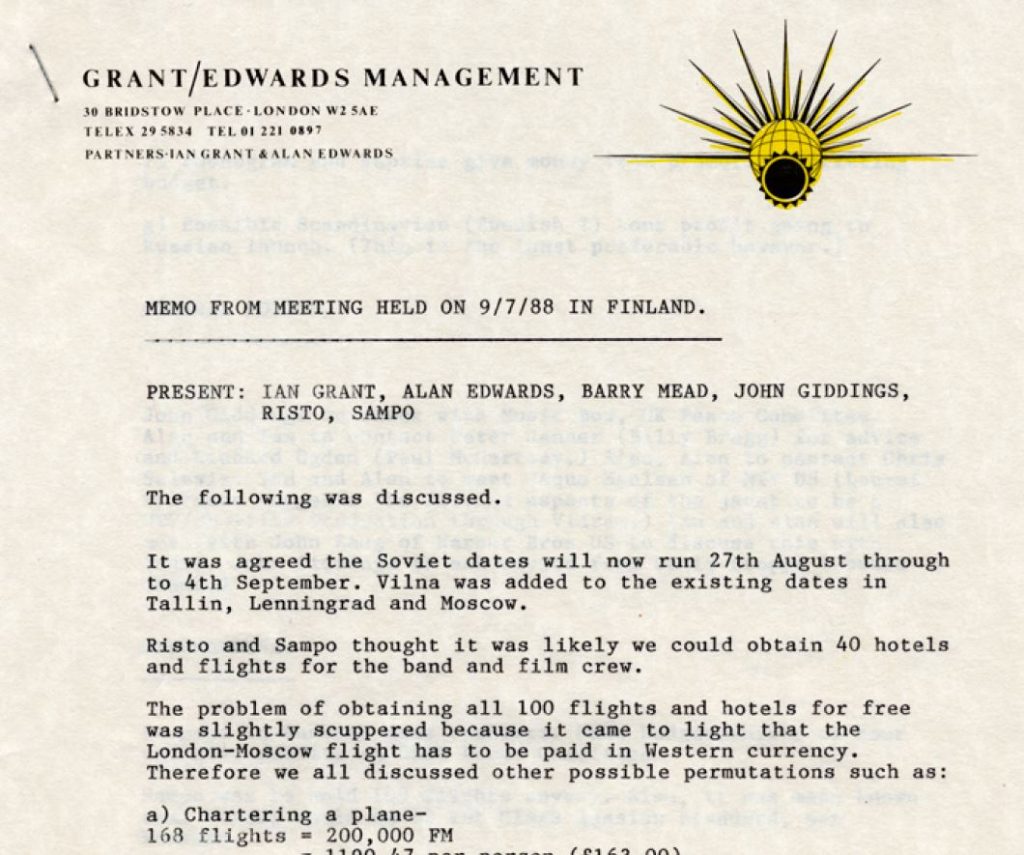
Big Country ended up performing what accounts to a five-day festival residency in Moscow, but there had been plans at one point for the band to actually tour the Soviet Union. A memo from a planning meeting on 9 July shows that at that point, dates in Leningrad, Tallinn, and Vilna are still part of the plan. Logistic challenges around transport and lodgings, and likely a lack of minimum financial guarantees, would eventually see all but the Moscow dates dropped.
First, though, there was the matter of the album launch at the Soviet Embassy in London on 21 September 1988, where Big Country performed a half-hour set (included on the Big Country At the BBC box set). This event served many purposes – it was the official album launch, a solid promotional event in itself, and the public announcement of the band’s impending journeys eastward. The band were officially presented with their visas for the upcoming trip, and invited the world press to come along to cover the event.
Most of the press were already aware of these plans. Many of them had in fact signed up for the trip. The event and process of bringing the press along to Moscow had been planned months in advance. Nothing was left to chance.
The announcement set up Big Country as a band that would have a part to play in what was happening on the world stage, representing an exchange of culture between the east and west as well. This was a factor in manager Ian Grant’s master plan. He shared his perspective in Classic Rock Magazine back in 2011: “My pitch to Stuart was; ‘Bono – Amnesty International. Sting – the rainforest. You – culture. East meets West. You could be kind of a figurehead for that.’ He bought it.”
The British press saw this event as a natural extension of music’s role in politics. The record label was also on board, backing the band’s ideas. Nick Rowe (Phonogram Records) said: “The music industry should be part of that. Music industry has broken many barriers and taken the lead where others have feared to go – we fed the world [with Band Aid and Live Aid]. The record industry should also be a big part of exchanging culture and ideas with the Soviets.”
Stuart certainly spoke passionately about this at the press conference: “We’ve always been aware of the fact that music can be more than entertainment. You can share ideas between people that can cut across cultural and language barriers.”
While the band might have had genuine motives for going over, there was obviously a hope that the resulting media coverage and overall interest would give the band headlines, attention, and positive long-term interest ahead of their album campaign and beyond.
There was always a risk that their plans could be seen as a cynical move done purely out of PR motives. To anyone who actually paid attention, it was very clear that most of the involved were genuinely inspired to be part of this. The feeling of history in the making on the world stage was hard to ignore, and the band tapped into that in a very positive way. Their desire to connect with the people in Russia never didn’t seem genuine.
Most journalists had a relatively balanced view of the band’s motives for going to the Soviet. Jonathan Ruffle (BBC Radio1 Producer) said: “There are probably two reasons they are going to Moscow. The first is probably a reason of conscience, and second, it is a marvellous hype. It would definitely develop a great deal of interest in the industry.”
Big Country had a reputation as earnest and down to earth people. Most journalists accepted that they were not known for huge, chest-beating statements and huge PR hoopla for the sake of creating hype. Stuart Adamson still addressed these concerns head-on, once saying “Obviously with a trip like this, there does exist the opportunity for people to exploit it to the maximum. That happens whether you play in Moscow, or whether you play in New York, or whether you play in London. I think it happens everywhere.”
In the River of Hope documentary, we get to follow the band and entourage on the trials and tribulations of their trip. This includes seeing the guests of the band gathering at Stanstead Airport on 30 September 1998 (the band having travelled a few days prior) where they took off on their chartered plane. Ian Grant estimated them to count 236, including people from newspapers, TV, radio, the music press, the record company, and promoters. The feeling of nervous excitement from not quite knowing what to expect is reflected in the overall mood and comments from passengers.
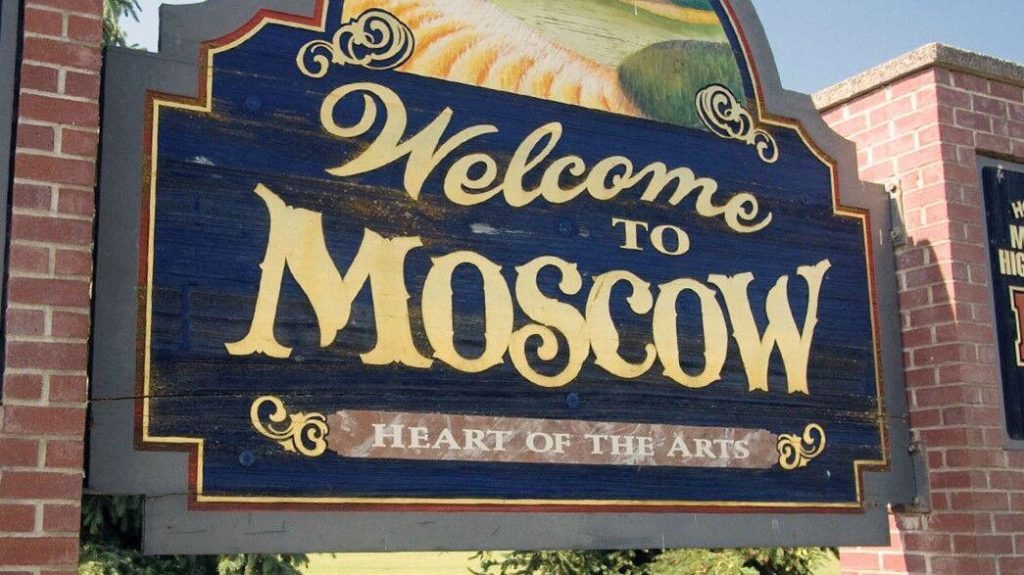
The arrival in Moscow was fairly dramatic. As the plane was in process of landing, another plane was taking off from the same runway. Quick manoeuvring brought the aircraft up again and disaster was averted, but the feeling of fear was real.
Having landed safely, it was time for vigorous immigration protocols to be observed, which dragged out for quite a while. It then took hours for the luggage to be brought in from the planes. This also meant that the backlog for a very thorough customs became sizeable. The trip was not turning out to be particularly glamorous or made to be practically easy.
The hotel check-in would prove to be another adventure. They arrived at the hotel late at night to find that the order of 200 rooms had somehow turned into an order for 200 beds. Some creative pair-ups had to be done just to get people to bed that first night, leaving further sorting out for later. In the documentary, Ian Grant commented: “I must say, allocation of room keys and stuff like that was certainly nothing I’ve experienced in any other hotel anywhere in the world, or am ever likely to experience ever again I think. It was a bit of, ‘We’ve got some rooms and I think some of them are yours, and if you stick with us we’ll get you your room before 4 o’clock in the morning.’ But we got there eventually.”
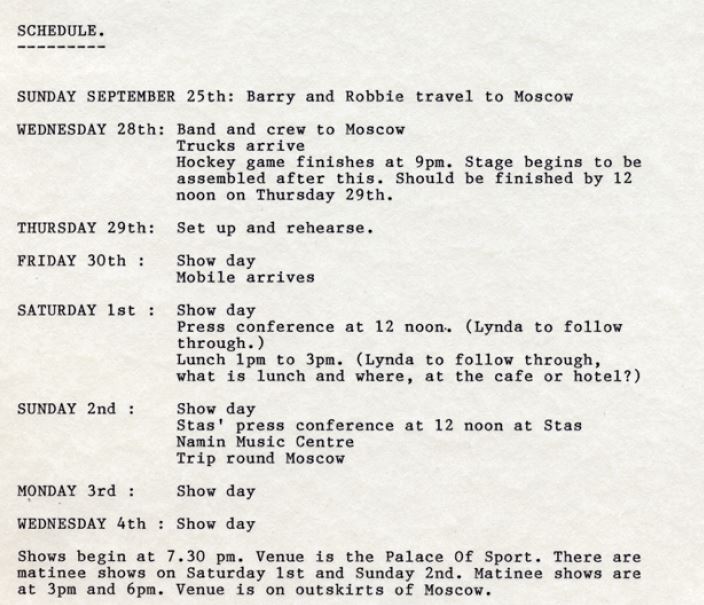
Meanwhile, the band and their organisation had been busy getting into production meetings and final preparations for the shows. One change that wasn’t confirmed until after the band had arrived was a switch of venue from the Lenin Sports Stadium to the Moscow Palace of Sports. This was done to allow more standing room at the show. Some of the shows were also meant to be filmed, and ensuring that they would have enough cameras was another last minute hurdle to cross.
The Soviet food was quickly found to be well below standard by one and all, described as downright “inedible” by parts of the entourage. The documentary shows them trying to identify the gelatinous, transparent, and weird-looking pieces of meat in their soup, and it is hard not to shudder. While those sequences were likely edited for effect, they were likely not exaggerating at all.
Guitarist Bruce Watson was not shy about airing his grievances publicly. In a TV interview in the Red Square in Moscow, he nearly caused a minor diplomatic incident when he spouted: “The foods have been pretty disgusting, it was terrible! Rat meat! Little bits of meat about that size, horrible!”
There had been warnings about the food situation, and a rich selection of foods had actually been brought along from the UK. This was – of course – confiscated ‘en masse’ at customs. It was released to them four days later, but they were instructed by officials that they were not allowed to cook it. They took their chances with the Jaffa Cakes they had brought along, as those did not have to be cooked.
Things were not found to be under control from an events perspective either. It was not popular that the band had opted to use Stas Namin to organise the tour as well as taking care of the set-up and practical stuff. The state appointed organisation Goskontsert usually had this role, and they may have felt threatened. It definitely felt like they used their position and influence to add extra challenges.
One of these challenges was getting the stage set up and ready to play on. In the River of Hope-documentary, stage manager Ron Maningley is asked how things are progressing. “Very, very slowly,” he says. “Everything takes hours in this place.” There were several issues with the equipment, and the sound checks were troublesome. “Tomorrow we’re getting the gas amplifiers out,” Adamson quipped. Fortunately, things were smoothed out with Goskontsert along the way. The set-up was completed, equipment became available, the challenges became overall easier, and the show could proceed.
Everything was however far from perfect. Technical challenges happened during most of the shows. On the 2nd, which was the night that would be released on video, an outtake shows Stuart telling the audience “Will you excuse us for a minute, we have an equipment malfunction here” after a song has broken down. There would be small breaks while stage hands and technicians did their best to fix things. This was hard, as there was a problem with the phasing of the power. It was cycled at 30 volts off the normal value, and the equipment struggled.

It is easy to criticize the Soviet side and their infrastructure. They did their best, and the hugely enthusiastic Stas Namin was clearly very invested in making it happen as well as possible. At the same time, this was the first event of this nature his team had done and they had a lot to learn. There was also a lot of extra work to be done to grease the wheels of change. “For us, this project is not commercial,” Namin said in the River of Hope-documentary. “We are not going to make money on it. We just try to arrange good times and comfort for the musicians, for the audience, and for the media people who came here. […] I think we have very talented musicians now. Before Perestroika they were underground, you know. Absolutely forbidden, and they did not have a future. And now we are trying to do [things like this]. It is difficult, because we have the same people as before – the same bureaucracy who said ‘no.’ But now, the law has been changed. It gives us permission to do things independently, and we’re trying to fight the officials and bureaucrats on this. We now have independent studios, not covered by the Ministry of Culture. They don’t cut our lyrics any longer, we can record what we want.”
Given Namin’s involvement with Russian bands, it is no surprise that the bill also included several Russian acts. More than just a Big Country show, the dates had a slight ‘festival’ feel with Big Country in the headliner spot. Whether the headliner status made sense is another thing. Asked how popular Big Country were in the USSR, Namin laughed and said “not popular at all. Nobody knows them. It’s a very good group, but when I try to promote them, everybody thinks it is country music, which is not very popular in the Soviet Union. This is why we put some very popular Moscow groups with them.”
What did Big Country think of the other bands on the bill? “I’ve never seen them!” said Bruce Watson in his infamous Red Square TV interview. “I couldn’t be arsed to watch them, to tell you the truth!”
In fairness, he also pointed out how insanely busy the band had been since they got there, with the current Red Square press outing being the first time they had the chance to look around town and catch their breaths a bit.
Having an international band appear on their arrangement – with the world press in tow, no less – no doubt gave the promoter a bit more clout and helped him add pressure to the parts of the system still trapped in the old mindset. The Soviet administration would not want to look like fools in front of the eyes of the world.
Amongst the reporters travelling to Moscow, were two Scottish-based student reporters. Kane Rutherford and David Miller caught Stuart Adamson unwinding back in his hotel room after the first concert on 30 September. His thoughts were primarily preoccupied with the people who came to see them play, which had made an impression on him. “The young people of the Soviet Union enjoy Western music and the music of their own bands. People will learn more about each other through music and they will break down barriers. I hope we have achieved something towards that. Even if nothing comes out of the concerts, it’s still enough to look into those kids’ eyes and know that we have made contact.”
As a journalist student at the time, David Miller was surprised with the amount of prejudice about the Soviet that was displayed amongst his journalist colleagues during their stay. “The big press coverage always disturbed me,” he said in a BBC report about the visit. “The way they have very set attitudes towards the Soviet Union. I think the band have tried to play down those attitudes and improve relations between the east and west, but a lot of the press – particular in North America – still seem to have very set ideas.”
For this trip though, particularly the British press was brought over in droves. Someone joked that approximately half of the entire British NUJ membership were in Moscow – a point that was brought home during the first few gigs. There seemed to be more foreigners than Muscovites. Some promotional activities were in order.
The band was promptly booked to play on a popular game show, lip synching a performance in front of the first prize: a plate of salted fish. Second prize: coloured pencils and a notebook. Who knows how much that TV appearance mattered, but at least there seemed to be a bit more music fans in attendance for the last batch of shows.
The concerts themselves were not outstanding by the band’s own standards. Technical challenges, unusual surroundings and the general stage set-up did not provide ideal conditions nor scream rock’n’roll. Bruce Watson admitted as much in the Red Square TV interview, saying “The gigs have been a bit strange – playing at the old ice rink, refrigeration and all that.” However, what they achieved was unique and marked a new era in cultural relations. As the audiences left the concert venue, they sang and danced. The message of peace in our time had reached the big country.
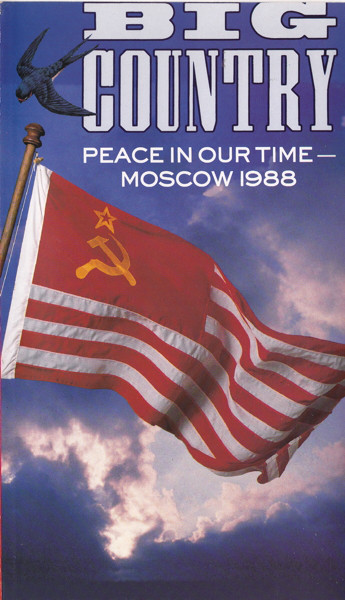
The band were always keen to make a personal connection with the people who came to see them, and the Russian shows would be no exception. It was harder, due to the distance between the stage and the audience. There was also the amount of security personnel keeping things in check. They can clearly be seen placed around the arena in the home video that was released of the event, called Peace In Our Time – Moscow 1988.
In this video release, we can see Stuart put down his guitar during an extended outro section of In A Big Country. He has decided to jump off the stage to get up close with the audience. He ends up shaking a lot of hands, sharing a few words and interacting with as many as he can manage during a few short minutes. He smiles, look them in the eye, and thanks them – anything to make that connection with their fans that the band always liked to make. It is a sight to behold to see Stuart flanked by suited men with grim, non-smiling faces while the fans around them behave like Big Country fans anywhere always do – dancing, clapping, smiling, and thrilled be able to interact with their hero. But, despite the ominous presence of the suited men it was allowed to happen.
In fact, several things signalled a change during these shows. As mentioned, a section of the audience were allowed to stand, whereas previously shows had been seating only. People were getting up even in the designated seating areas. By the end, there was a dancing, waving, chanting (and very happy) crowd. The soldiers and security men were stoically standing there throughout, but allowed the audience to show their enthusiasm. Their presence was becoming more decorative than it had been in the past. Who knows if it helped that they knew they had video cameras on them?
Drummer extraordinaire Mark Brzezicki was delighted to see the joy in the audience: “Normally when I’m playing I’m buried behind my drums and I’m thinking ‘song – song – song’ and I get lost in the music. I tend to get in a trance, hence the funny faces that drummers pull. But this time, I was actually looking out and going, wow! I’m actually in Moscow, and they’re standing up! It sounds trivial to us, this standing up at a gig, but I’m going, wow! This is Moscow, and they’re standing up! And they’re actually getting into it! They were trying to sing the words and things… it was fantastic! I had shivers down the spine. Brilliant!”
Guitarist Bruce Watson felt similarly, and was particularly impressed with how many songs the crowd seemed to know given that their albums weren’t available there. He said, “They may have heard a few of the songs through pirate or underground radio, and I think they have heard a couple of the hit singles. They haven’t heard any of the albums at all, but I think they are doing good! I think the crowds are good. They are desperate for music, definitely.”
The fifth and final show at the Palace of Sports was played on 4 October. After that it was time to say goodbye to newfound friends and travel home, but not without a few final surprises.
Big Country had invested £500,000 of their own money in film crews, sound equipment, lights, and accommodation. They had hoped to recoup some of this through the shows, but found that Soviet regulations stated that any profits made in Russia couldn’t be exported back home with the band. The group was also stunned to hear the Soviet authorities tell them that they had to “donate” their valuable amplification system to the local music scene, for the benefit and future use of Muscovite rockers. When this turn of events was brought up later on, Adamson managed to raise a ghost of a grin, leaving it at “It’s a Scottish trait to have a sense of humour in times of adversity.”
A music video for the track Peace In Our Time would be produced a bit later, containing footage from these concerts as well as showing the band about town in Moscow. Unfortunately it would take four months for the music video to be released (in February 1989), which was likely a bit too long after the trip itself to contribute to the newsworthiness of it all. It’s still a great video.
A few years later, The List interviewed Bruce Watson about his Russian adventure. “The Soviet Union was the strangest experience I’ve ever had,” he said, being described by the journalist as ‘a man still looking like someone in the grip of chronic culture shock.’
The album title/packaging sent out some very strong statements at the time, underpinned by the Russian Embassy album launch and trip to Moscow. Making statements about international relations could be dangerous waters for a rock band to sail into, and the huge PR activities and hype surrounding the Moscow trip may even have overshadowed the music. Bruce Watson is less precious about the theme of the album and press campaign: “To me all of that isn’t necessary. When we put all the songs together as an album, the strongest title we had was Peace In Our Time. And I must admit I wasn’t too keen on it, because I thought it was too big a statement to make anyway. We had no intention of playing Moscow or doing the Russian Embassy thing. Ian [Grant, manager] actually thought it up, and it just sort of escalated from there. The band had nothing to do with that at all. It’s just a guy over at Phonogram. We just said, ‘Here’s the record, here’s the lyrics, do your worst with the sleeve,’ and that’s what they came up with. It’s just packaging. Whether it’s released like that or in a brown paper bag really doesn’t mean anything to me at all. The only thing that means as much to me is that we can write a song that we’re all pleased with, and go out and perform it to the best of our ability.”
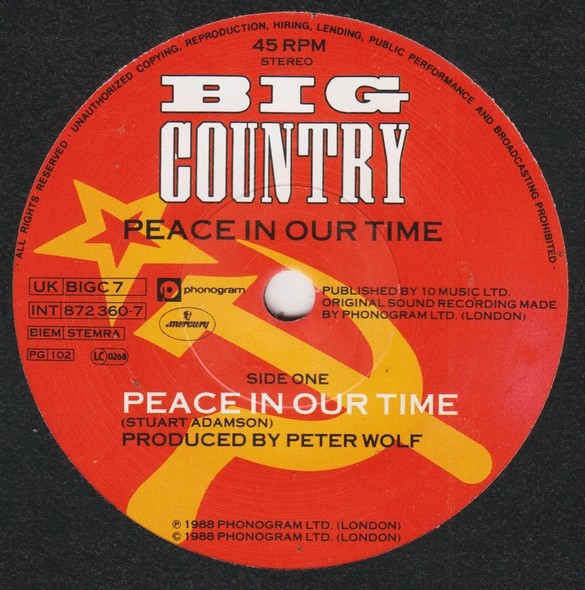
The question about whether such an event could be exploited commercially or politically had been put to Stuart Adamson by BBC during the USSR stay. Adamson responded, “I don’t think working in the music business you ever can avoid it completely. I think that would be an overly naive attitude to take. I think we are very open and very straightforward about our work over there. We know from within the group that our motives are as pure as they could be, and that’s why I sleep easy at night.”
As Adamson further pointed out, if monetary gains were the most important thing for the band, Russia was a poor choice of country to raise their profile in to get more income from record sales. “Our records are not available in the Soviet Union at all,” he said, “unless it’s through bootleg tapes. [What we do] is done purely as a gesture of friendship and worth. Hopefully what it means is that it will open things up not only for other bands to come here and play, but for Soviet bands to come and play in Western Europe as well.”
As mentioned, Ian Grant brought up the possibility of Adamson becoming a figurehead for culture. That really did not last much beyond the Soviet trip, but while that was going on, Adamson was more than happy to speak about what the band was trying to do, about the people he had met, and about how he felt music transcended borders and language barriers. His earnestness felt (and no doubt was) very genuine, and you can almost see how the ‘culture’ angle was one that might had worked for him. It was however back to business as usual when normal touring started.
A more permanent ‘figurehead’ role was not in the cards. Adamson wasn’t Bono or Sting, so Grant pegging him for a similar media role was and is surprising. Adamson was no less genuine or passionate than Bono or Sting, but unlike them, he did not thrive on being an extrovert spokesperson on the world stage 24/7. Bono or Sting never stopped – when they weren’t involved in music activities, which often included campaigning for their causes, they kept it up privately with personal appearances and separate initiatives. Adamson, however, cherished home life, his privacy, and needed to switch off now and then. At various points throughout his career he would draw a line and pause band activities to be at home with his family. Adamson easily had the charisma and inner flame to be a convincing spokesperson had he wanted to, but it was always going to be on a different level than Bono. His approach was more personal. He would give encouragement wherever he could, and talk about what was dear to him when asked, but playing the game for PR’s sake on the world stage was not his way. Nor was it particularly the way of anyone else in the band. The need to go home at the end of the show was always too strong. It was likely what kept them grounded.
Always the one to bring things down to earth, Bruce Watson was clear about what he thought about PR angles, figurehead overtures, and catering to the press for coverage: “All that counts to me are the songs, the people in the band, and obviously the people who come to the concerts and get involved. That’s rock’n’roll to me.”
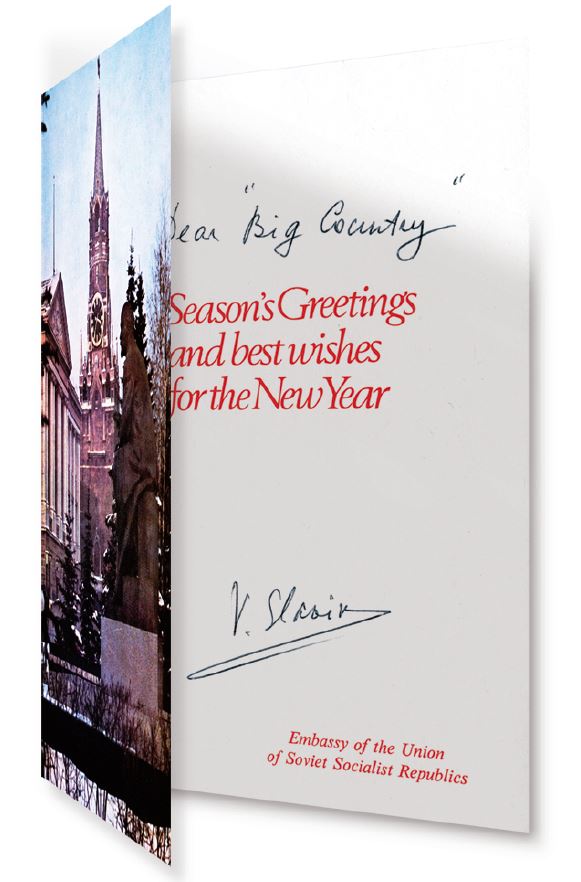
In his liner notes to the 1996 remaster of the Peace In Our Time album, it says a lot that Adamson doesn’t write about (or even mention) the actual album at all. Instead he spends the entire text looking back at their Soviet adventure. Eight years removed from it, the impressions from that trip still looms large. The earnest comments of 1988 are gone. In 1996, he was not able to look back at it without a certain level of ironic distance:
“Moscow. 1988. Gorbachev, Perestroika. A new freedom. The same security force. Endless concrete apartment blocks. Suspicion. Shortages. Money changers. Hard currency hypocrisy. All the clichés come alive. Nothing has prepared me for this. No connections. A brand new thrill. The air thick with the fear of change and the need for it. Living black and white. You know the words but not what I’m saying. My gestures are alien, unrecognizable. I hope they’re videoing this. What a glorious futility. The last war of attrition. Levis and Coca Cola Vs. Smokin’ Joe Stalin, winner to be decided by a copout. Brought to you by those friendly folks in lumpy suits. Well, at least it made the papers for a week.”
They say that hindsight is always 20/20. It is easy to look back at the whole Soviet adventure with a flair of negativity – whether it is with a sense immense culture shock, the ‘rat’ meat menu, the underhand way of losing your income and/or equipment, as a financial sinkhole, the PR possibly being misfocused (the album being tailored for America, while the big PR activities focused on Soviet), or – probably worst of all – being accused of doing a calculated move done solely to get press and attention. It’s all been mentioned at some point along the way.
This is however the wrong focus. What should never be forgotten was the genuine excitement that the band and people around them had about going there. You see it in every interview done before they left, and also in clips done while they were there. From the perspective of the four guys in the band, the idealism in what Big Country did was always genuine. The idea of going to Russia may have been Ian Grant’s baby, but it wasn’t a strange concept for Big Country. It was a fitting idea for the band that was always about breaking down barriers through music. The footage of them performing in Moscow and interacting with the fans there speaks with the same sincerity that all of their performances do. It is an exemplary demonstration of what the band has always been about and what they do best. It was a band reaching out to people through music. Their energetic and emotive performances have always been felt by every audience – regardless of their culture or nationality. The faces of the people in attendance at the Moscow shows alone shows why the trip was a huge success on the level that matters most when all is said and done.

Facebook Comments